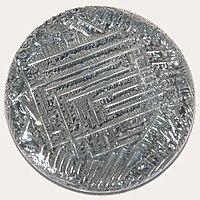
Photo from wikipedia
Limited by the insufficient active sites and the interference from breath humidity, designing reliable gas sensing materials with high activity and moisture resistance remains a challenge to analyze human exhaled… Click to show full abstract
Limited by the insufficient active sites and the interference from breath humidity, designing reliable gas sensing materials with high activity and moisture resistance remains a challenge to analyze human exhaled breath for the translational application of medical diagnostics. Herein, the dual sensing and cooperative diagnosis is achieved by utilizing metal-organic frameworks (MOFs) and its derivative. The Fe-MIL-101-NH2 serves as the quartz crystal microbalance humidity sensing layer, which exhibits high selectivity and rapid response time (16 s/15 s) to water vapor. Then, the Co2+ and Ni2+ cations are further co-doped into Fe-MIL-101-NH2 host to obtain the derived Co/Ni/Fe trimetallic oxides (CoNiFe-MOS-n). The chemiresistive CoNiFe-MOS-n sensor displays the high sensitivity (560) and good selectivity to acetone, together with a lower original resistance compared with Fe2 O3 and NiFe2 O4 . Moreover, as a proof-of-concept application, synergistic integration of Fe-MIL-101-NH2 and derived CoNiFe-MOS-n is carried out. The Fe-MIL-101-NH2 is applied as moisture sorbent materials, which realize a sensitivity compensation of CoNiFe-MOS-n sensors for the detection of acetone (biomarker gas of diabetes). The findings provide an insight for effective utilization of MOFs and the derived materials to achieve a trace gas detection in exhaled breath analysis.
Journal Title: Small
Year Published: 2022
Link to full text (if available)
Share on Social Media: Sign Up to like & get
recommendations!